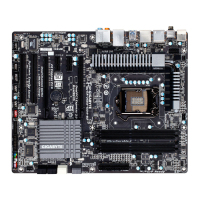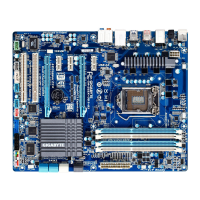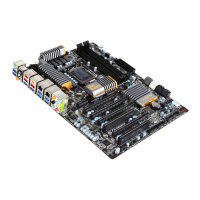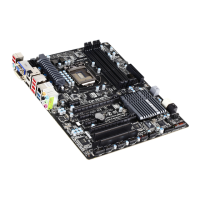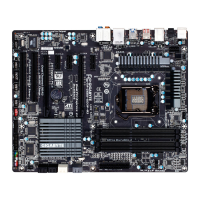
Do you have a question about the Gigabyte GA-Z68XP-UD3P and is the answer not in the manual?
| ECC | No |
|---|---|
| Non-ECC | Yes |
| Memory voltage | 1.5 V |
| Memory channels | Dual-channel |
| Number of memory slots | 4 |
| Maximum internal memory | 32 GB |
| Supported memory clock speeds | 1066, 1200, 1300, 1333, 1600, 1800, 1866, 2133 MHz |
| System bus rate | 5 GT/s |
| Processor socket | LGA 1155 (Socket H2) |
| Processor manufacturer | Intel |
| Compatible processor series | Intel Core i3, Intel Core i5, Intel Core i7 |
| USB 2.0 connectors | 3 |
| Number of Parallel ATA connectors | 0 |
| Headphone outputs | 6 |
| USB 2.0 ports quantity | 8 |
| Audio chip | Realtek ALC889 |
| Component for | PC |
| Motherboard chipset | Intel Z68 |
| Audio output channels | 7.1 channels |
| Motherboard form factor | ATX |
| Compatible operating systems | Windows 7/Vista/XP |
| PCI Express slots version | 2.0 |
| Maximum graphics card memory | 1759 MB |
| Controller 2nd interface type | Marvell 88SE9172 |
| RAID levels | 0, 1, 5, 10 |
| LAN controller | Realtek RTL8111E |
| Networking features | 10/100/1000 Mbit/sec |
| Ethernet interface type | Gigabit Ethernet |
| BIOS type | AWARD |
| ACPI version | 1.0b |
| BIOS memory size | 64 Mbit |
| Depth | 244 mm |
|---|---|
| Width | 305 mm |
Guidelines and procedures to follow before installing hardware components.
Detailed list of hardware specifications for the motherboard and its components.
Step-by-step guide for safely installing the CPU and its cooling solution.
Instructions for installing RAM modules, including dual-channel configuration.
Procedure for installing PCI Express or PCI expansion cards into available slots.
Guide to configuring multi-GPU setups for enhanced graphics performance.
Identification and function of all external ports and connectors on the motherboard.
Identification and function of all internal headers and connectors on the motherboard.
Displays the screens that appear during the computer's boot-up process.
Overview of the BIOS Setup main menu and navigation functions.
Advanced settings for CPU, memory, and voltage configuration for performance tuning.
Configuration of system date, time, and basic hardware settings.
Settings for boot order, system security, and other advanced BIOS options.
Configuration for onboard devices like SATA, USB, LAN, and Audio.
Settings to configure system power states, wake-up events, and energy saving.
Monitoring of system temperatures, voltages, and fan speeds for hardware health.
Resets BIOS settings to the safest, most stable factory defaults.
Resets BIOS settings to the factory defaults for optimal performance.
Setting passwords to restrict access to BIOS setup and system boot.
Saves current BIOS settings and exits the setup utility.
Exits the BIOS setup utility without saving any changes.
Step-by-step guide for installing essential chipset drivers from the driver disk.
Information and installation of GIGABYTE utilities and bundled software.
Access to application guides and motherboard manuals.
Information on how to contact GIGABYTE support and offices.
Displays basic system information about the installed hardware.
Links to GIGABYTE's website for downloading the latest BIOS, drivers, and applications.
Quick links to install recently developed GIGABYTE utilities.
Utility for quick system data backup and restoration.
Tools for updating the motherboard's BIOS using Q-Flash or @BIOS.
Software for fine-tuning system settings, overclocking, and monitoring.
Technology for optimizing power savings and efficiency.
Tool for easy data sharing between computers on a network.
Suite of utilities for system management, performance, security, and recovery.
Tool for enabling system power savings via a Bluetooth cell phone.
Utility for configuring RAID arrays for enhanced drive performance.
Utility for overclocking and system management via internet-connected devices.
BIOS configuration utility accessible from the Windows environment.
Guide for installing and configuring SATA hard drives and RAID arrays.
Specific instructions for configuring SATA ports managed by the Intel Z68 chipset.
Specific instructions for configuring SATA ports managed by the Marvell 88SE9172 chip.
Steps for installing SATA drivers and the operating system (Windows 7/Vista/XP).
Guide for setting up audio jacks for speakers and microphones.
Steps to configure multi-channel audio output and speaker assignments.
Instructions for setting up digital audio output via the S/PDIF connector.
Guide to activating enhanced surround sound audio effects.
Steps to set up and configure microphone input for recording.
FAQs and a troubleshooting procedure to resolve common system issues.
Common questions and answers regarding BIOS options, system behavior, and driver issues.
A flowchart-based guide to diagnose and solve system startup problems.





